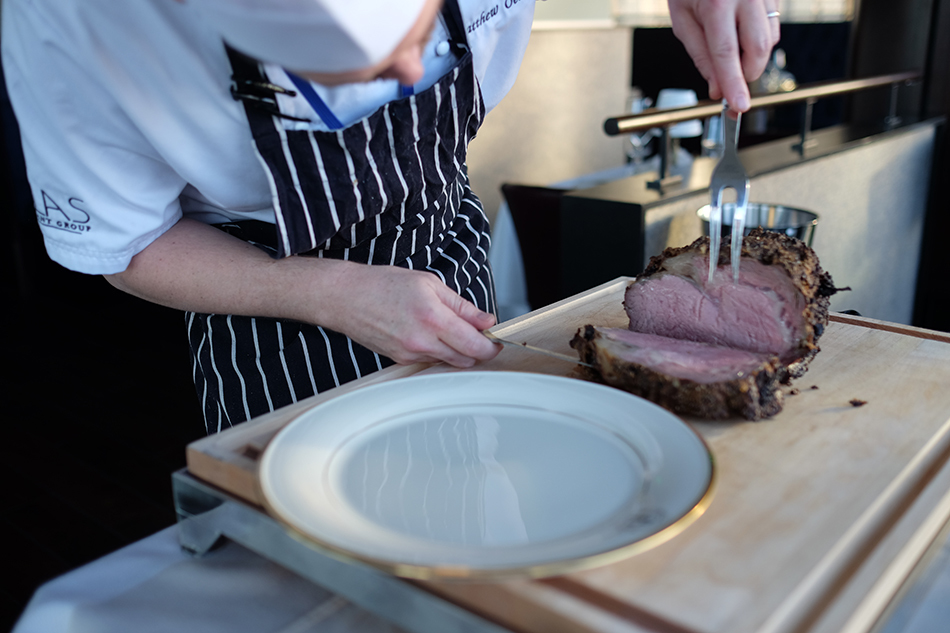
Matthew Oetting was initially hired by the Atlas Restaurant Group to oversee the kitchen at Bygone, but first worked as executive chef at the group’s Loch Bar for two years, while waiting for the fine-dining restaurant to open at the top of the Four Seasons. With the recent restaurant debut, Oetting, who came to Baltimore from kitchens in Miami (Scarpetta) and New York (Telepan, The Modern), talks nouvelle cuisine, vintage menus, and the local restaurant scene.
I know you did a lot of research as you were conceptualizing and creating Bgyone’s menu. What was your process?
When I was doing research, I was having a hard time finding menus from the mid-19th century. I reached out to the research librarian at [my alma mater] Arizona State University and he put me in contact with a colleague named Chris, who specializes in culinary history—he was an amazing resource. He started sending me menus from the period. The first few that he sent were from the ’20s, ’30 and ’40s— he ambiance of The Great Gatsby was the era they were going shooting for when they were conceptualizing Bygone.
But the menus that came through were extremely bare bones. In the era of the ’20s, ’30s, and ’40s, the menus aren’t all that impressive, not many had composed dishes with the protein, the starch, the vegetables, the sauce all on one plate. It was all very broken up—there was the vegetable section, there was the potato section, the chop section, and the seafood sections. Some of these menus had 15 different sections on one page. Chris said to me, ‘You have to remember what was happening in history at that time—they were just coming out of the Depression and then World War II. People weren’t spending money in late ’20s, early ’30s and through the war.’ Eating out wasn’t really a focal point.
So how did you arrive at this particular menu full of French-inspired classics?
Chris said, ‘If you want to look at menus from the ’50 and ’60s, you’ll see something a lot different, so he started sending menus from that era, and they were incredibly impressive. It was the dawn of nouvelle cuisine, and chefs started putting together composed plates. People were going to restaurants after World War II and had money to spend—that’s where the inspiration for the menu started to take shape. I had 40 menus in these huge, three-ring binders that I used as a basis for the Bygone menu.
You’ve said that this is the food that speaks to your heart and soul. Can you elaborate?
A lot of the preparations are very home-style. Cooking dishes like whole roasted duck and chicken and roasted brisket come from the heart. A lot of the dishes have long preparations that take two, three, four, five, six days. Preparing these kinds of dishes gives me a warm feeling. Being able to transform it for the modern palate is what I’m about.
Are there any menus in particular that spoke to you?
One of my favorites was The Golden Lion in Seattle. It had a lobster section like we do at Bygone, it had frog’s legs and crab legs and medallions of veal Oscar, and all of these great classic preparations. I was also inspired by menus at The Oak Room in the Plaza Hotel in New York. I collected menus from the Beverly Hill Hotel menu in 1956 and the 21 Club’s 1961 menu.
The food from this particular period was flexible.
There’s a lot of nostalgia here for an older crowd, but there are younger people for whom this will be new. Do you hear that from customers?
Yes, there are a lot of millennials coming in, and I think they like the throwback—they recognize that it’s a throwback, but don’t know what it’s a throwback to.
Did you draw on any other inspirations for the menu?
New Orleans at that time, and still somewhat today, was a culinary mecca. French Creole cooking was extremely popular at the time. I put Creole snapper blackened and served with crawfish étouffée and dishes like Cajun fried cauliflower on the menu as an homage.
If you’re a chef, even if you’re opening a New American spot or a steakhouse, you need classical training. Why is that?
It’s the foundation of everything you do modernly. How could you know how to make Hollandaise foam if you can’t make Hollandaise? How could you know how to make a preparation using Bordelaise sauce, if you don’t know how to make Bordelaise sauce? That’s what makes Bygone so cool. It takes dishes like tuna ravigote and vichyssoise and brings them back to the forefront. These are dishes that people have forgotten about for 50 years—now they are new and exciting again. Without the understanding of what nouvelle cuisine was at that time, we wouldn’t be anywhere. Paul Bocuse just passed away and his impact on the culinary community was huge. Without him, we wouldn’t know how to make some of the things that we have today or have some of the chefs that we have today.
These dishes are really complicated—it’s not like working somewhere where you’re just flipping burgers on the grill. Has that made it hard to find people to cook?
We’ve had a lot of cooks come through, and I’ve had to let a lot go. I’ve had to say, ‘Listen, I’m sorry, it’s not that you’re not a good cook or can’t cook, it’s just that you’re not ready for this particular kitchen.’ This is high end—you have to be very skilled and have a very strong foundation to know what you’re doing here.
When you get out to eat, where do you like to go?
I just went to Alma Cocina Latina. One of my cooks works as a sous chef there. I went there and had great arepas. La Cuchara is really great. I also like McFaul’s IronHorse Tavern near my house—there’s always good food and everyone needs a local spot.
How have you seen the culinary community change since you moved here?
I’ve seen the culinary community change in the two years since I’ve moved here. I see our community of chefs getting bigger and more prestigious. I don’t know what my direct impact on that is, but it’s a great feeling to know that you’re in a blossoming community.
What’s the most valuable piece of advice you ever got from a mentor?
When I asked to move from my externship as garde manger to a paid line cook at the pasta station at Union Square Cafe, Chef de Cuisine Sandro Romano at told me, ‘You don’t become an astronaut overnight.’
